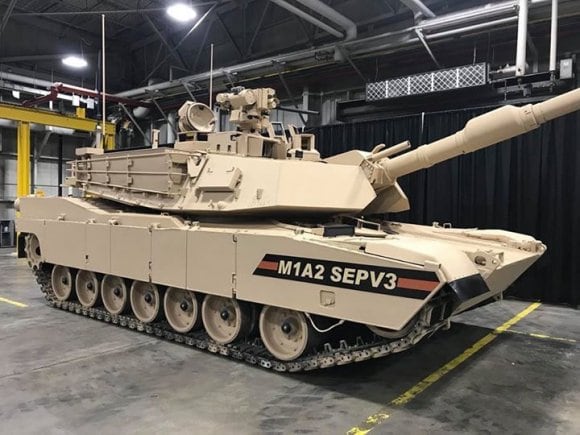The first of a batch of upgraded M1A2 Abrams tanks has hit the Army, with more improvements coming in the next few years.
Earlier this month, the first of six M1A2 System Enhancement Package Version 3 Abrams tanks rolled off initial production at the Joint Systems Manufacturing Center in Lima, Ohio, the Army announced.
These are the first upgrades to the Army’s 1,500-tank fleet. They fall in line with overall Army plans to enhance lethality and improve its ground combat systems, preparing them for potential fights with near-peer adversaries.
Another such improvement was the recent addition of a 30 mm cannon to many of the Army’s Strykers, which began deliveries last year.
“This version is the most modernized configuration of the Abrams tank, having improved force protection and system survivability enhancements and increased lethality over the M1A1 and previous M1A2 variants,” said Lt. Col. Justin Shell, the Army’s product manager for Abrams.
The version three enhancements address on-board power, electronics, computing, weapons, force protection and sensors. They are primarily a bridge to the version four variant planned for the 2020s, Program Executive Office-Ground Combat Systems spokeswoman Ashley Givens told the media.
The M1A1 Abrams tank has been in use since the 1980s. The M1A2 version being enhanced has been in production since 2005, according to officials.
According to the Army, the version three upgrades include:
Joint Tactical Radio System: The new system integrates various radio types into the system and allows for network readiness and interoperability with the rest of the brigade combat team.
Power Generation and Distribution: This enhancement includes improved amperage alternator, Slip Ring, Enhanced Hull Power Distribution Unit/Common Remote Switching Modules, and the Battery Monitoring System. These changes compensate for increased power demands of newer tank equipment.
Line Replaceable Unit/Line Replaceable Module redesign: New modules allow for troubleshooting within the system to the card level without the need to remove the entire system to conduct repairs.
Counter Remote Control IED Electronic Warfare version 3: this is the latest version of the tank’s counter-IED equipment.
Ammunition Data Link: The ADL allows tankers to program the M829A4 Advanced Kinetic Energy and Advanced Multi-Purpose rounds.
Auxiliary Power Unit: Allows tankers to operate the on-board system during silent watch operations for reduced detection probability.
Armor Upgrades: Undisclosed advances in ballistic protection.
The enhancements are being installed at both JSMC in Lima and at the Anniston Army Depot in Anniston, Alabama.
The version four variant is scheduled for testing in 2021, production in 2023 and fielding in 2025, Givens said.
Version four will add new laser rangefinder technology, color cameras, advanced meteorological sensors, ammunition data links, laser warning devices, integrated on-board networks and more lethal, wider ranging 120 mm tank ammunition.
The lethality advances center around the third generation Forward Looking Infrared camera, which can detect the enemy at greater distances and through most obscurants.
The version four Abrams will also carry a multipurpose 120 mm round. The AMP round will take the place of the High Explosive Anti-Tank round, the Multi-Purpose Anti-Tank, the M1028 Canister to attack dismounted infantry, and the Obstacle Reduction Round that’s used destroy large obstacles.
"These vehicles are not just about assuring our allies, or deterring or coercing potential adversaries," said Maj. Gen. David Bassett, program executive officer for Ground Combat Systems, in a statement. "They are about compelling our enemies and winning the multi-domain battle."
Todd South has written about crime, courts, government and the military for multiple publications since 2004 and was named a 2014 Pulitzer finalist for a co-written project on witness intimidation. Todd is a Marine veteran of the Iraq War.




